|
Tupolev Tu-22M3
(NATO "Backfire C")
by "Bondo" Phil Brandt, IPMS
14091
|
 |
|
Tupolev Tu-22M3 (NATO "Backfire C") |

HyperScale is proudly supported by
Squadron.com
Andrei Tupolev's Backfire series of strike aircraft resulted
from a clever ploy against the design bureau of his brilliant former
student, Pavel Sukhoi.
The exotic, XB-70 look-alike Sukhoi T-4 "Sotka" had greatly
impressed Soviet planners, but Tupolev convinced them of the great
monetary savings that could be realized by modifying the
problem-plagued Tu-22 Blinder. What Tupolev had really done,
however, was to design a wholly new aircraft which decisively
elbowed the T-4 program out of the picture with only two airframes
completed.
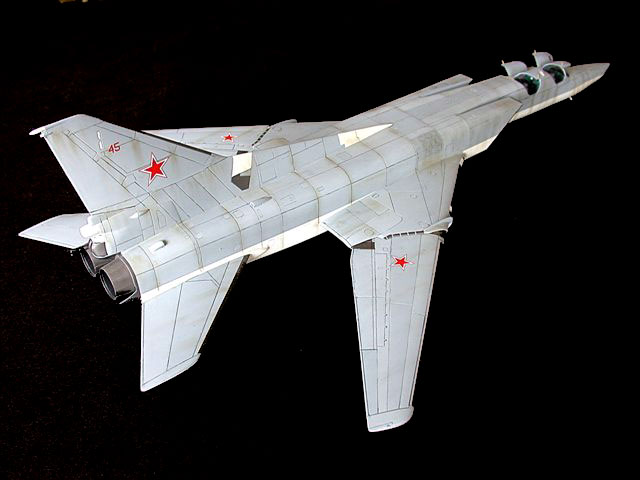
The Backfire--the M3, or "C", is the definitive variant--has
soldiered on to be one of the most feared and respected Soviet air
assets, and its capabilities have been the subject of many SALT
negotiations.
References
-
Blinder/Backfire color feature, “World
Airpower Journal”, Vol. 33 (Summer 1998).
-
"Tupolev Tu-22 'Blinder'; Tu-22M
'Backfire' " by Yefim Gordon and Vladimir Rigmant, Aerofax (Midland
Publishing Ltd.)
The hard-to-find ESCI Backfire B and C kits are the only ones
that have been released in 1/72, and, typically for this brand, they
both present many areas that need to be corrected. The overall
molding is decent, albeit with too-aggressive engraving--I really
couldn't face up to redoing the close-to-Matchbox "trenches"-- and
rather soft detail.
Fuselage
A serious omission--one that fat, dumb and happy Bondo didn't
discover until almost ready for final paint--is that the fuselage
length forward of the intakes is one inch short. That's right, four
scale feet! Sooo, it was manufacture-a-plug time at Bondo
Industries.
And, while we're talking fuselage, the downsweep on the tops of
the C intakes should be increased, although I passed on that one.
Cockpits
The cockpit configuration as presented by ESCI is pure fantasy,
not even close to the real thing. The actual aircraft is a four
place, side-by-side configured bird with individual clamshell crew
hatches on the top of the fuselage, not the single entrance hatch
behind the nosegear as modeled by ESCI. And, there is no "pass
through" access between the forward and aft cockpits.
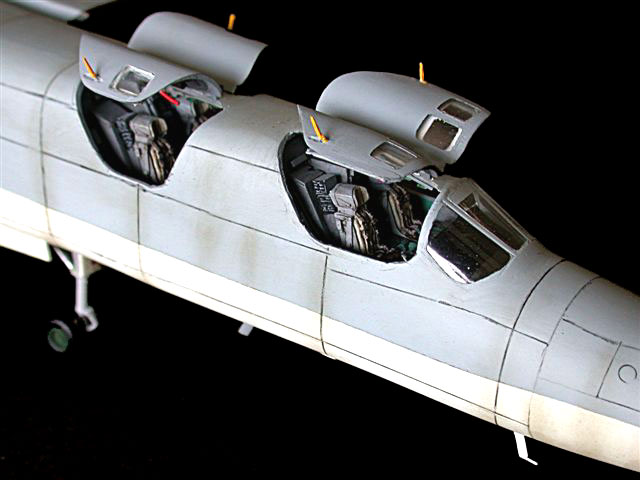
I elected to scratchbuild the whole shooting match, using the
suprisingly similar KC-135 PE pilot's instrument panel from True
Details and, for the rear navigation/ECM cockpit, miscellaneous PE
panels and consoles from the spares box. Buklheads and side panel
details were also scratched.
Seats used (unique seats are used in the real thing) are
represented by modified (stabilizer tubes removed) True Details
K-36s. Hatches were cut out of the fuselage top per drawings in WAPJ,
and, in the case of the front ones, the thick, one-piece clear
canopy was carefully sectioned and integrated into the assembly.
Hatch interior detail was scratchbuilt from the same article.
Click the thumbnails
below to view larger images:
Radome
Radome profiles vary significantly between the B and C versions,
but ESCI chose to try the quick and dirty by skipping the work of
re-doing a new radome for the C. I used lots of A&B epoxy putty to
create the severe radome upsweep and transition from ogival curve to
wedge in the most forward portion.
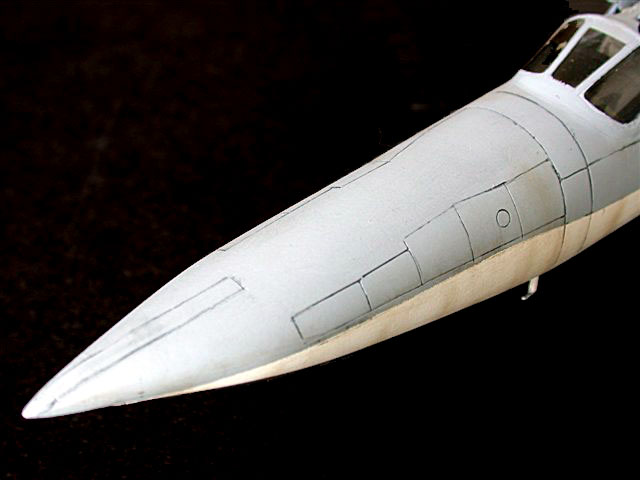
Distinctive radome panels were scribed per the WAPJ pix.
Aft Gun Turret
Again, ESCI has simply skipped accurizing the "stinger" of the C
version, so I deep sixed the hokey side-by-side 'cannons' and
scratchbuilt proper over-and-under twin GSH-23 cannons. Per WAPJ pix
I also added a small platform under the tail radar warning radome.
Landing Gear
The gear struts are rather simple, but because of the large
surface of the airframe, they're largely hidden. I left 'em alone,
but did purchase a set of Equipage prepainted resin wheels w/rubber
tires (Lindenhill Imports). Unfortunately, these proper wheel/tire
assemblies are larger in diameter than those in the kit,
necessitating a redo of all three axles.
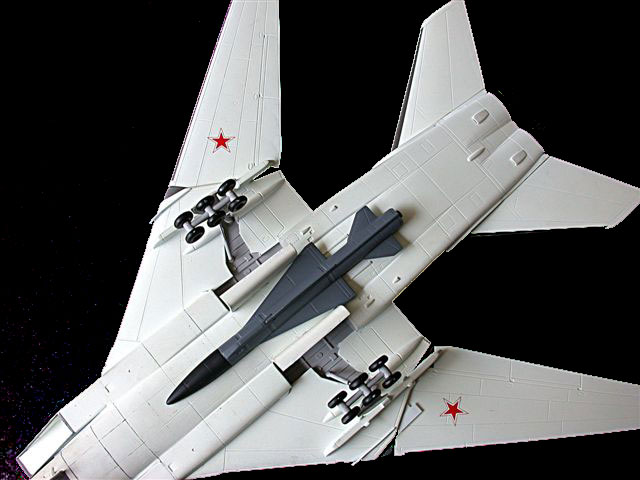
Because a show was right around the corner, timewise, I went
with the kit wheels, and have still not installed the correct ones;
another "to do" item!
Weapons Pylons
Large external pylons are provided, but the big cruise missiles
that should be mounted there interfere seriously with the maingear
doors, so I portrayed a missile mounted in the under fuselage
recess. In the real world, the C version carries the missiles almost
exclusively under the wings, and two of these big suckers is a
significant load, kinda like Senior Bowl B-52Hs lugging two Lockheed
GRB-21D drones! The Backfire wing trailing edges were notched to
clear the aft portion of the pylons per the WAPJ pix and drawings.
I custom mixed the basic bluish gray upper color from Polly
Scale acrylic, creating two slightly varying additional shades for
'scale effect' panel differentiation; lotsa masking, naturlich!
Operational Soviet birds suffer the rigors of weather and budgetary
constraints, and can get very dirty.
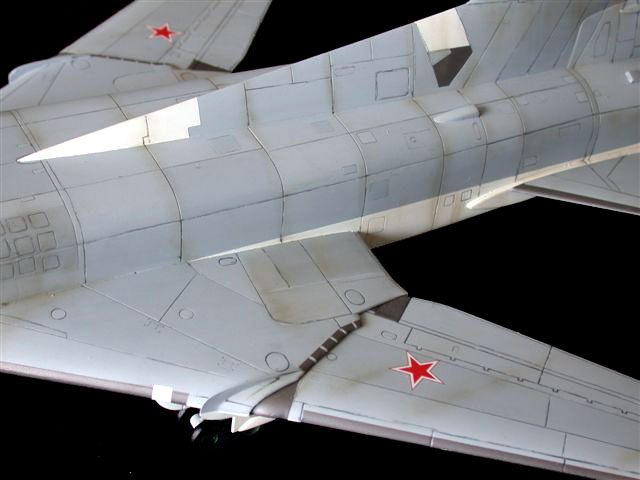
Once I saw the degree of airframe 'groadiness' in the WAPJ pix,
I didn't spare the burnt sienna wash and pastels. National markings
were from an Aeromaster Soviet fighter (La-7, IIRC) sheet.
Funny how Bondo, a retired TAC-trained 'killer', keeps reverting
to Evil Empire aircraft. I dunno; I guess it's a fascination with
the relatively unknown. One of these days, I've gotta get with the
program on my personal A-model Vark!
Click the thumbnails
below to view larger images:
Review and Images Copyright © 2002 by
Phil Brandt
Page
Created 17 December, 2002
Last updated
04 June, 2007
Back to HyperScale Main
Page
Back to Reviews
Page
|
Home
| What's New |
Features |
Gallery |
Reviews |
Reference |
Forum |
Search